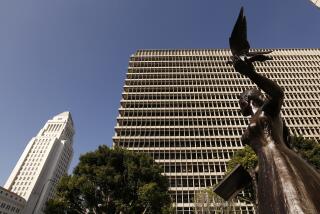CalPERS documents show more fees paid to Alfred Villalobos
- Share via
SACRAMENTO — California’s public employee pension plan disclosed millions of dollars in new fees paid to a former board member who represents private investment funds, triggering fresh calls for reforms.
Documents released Wednesday show that Alfred J.R. Villalobos was paid nearly $18 million for his work as an intermediary for a Los Angeles real estate investment fund and other clients. That’s on top of the $53 million in fees disclosed last month.
The fees paid to Villalobos and his Stateline, Nev., business “are shocking to everyone,” said Rob Feckner, president of the California Public Employees’ Retirement System board. A full inquiry is needed to evaluate how those commissions compare with those paid by other investment funds, he said.
Villalobos, a former member of the CalPERS board and a onetime Los Angeles deputy mayor, has denied wrongdoing and said he is cooperating with inquiries by investigators for CalPERS. He did not return phone calls to discuss the latest disclosures.
Concerns about the role of intermediaries in pension fund investments have grown in recent months. The relationships are being examined by the Securities and Exchange Commission and the attorneys general of New York state and California.
Disclosures ordered in recent months by the CalPERS board have begun to show the extent to which money and influence may have played a role in the way the state’s pension money is invested.
State Treasurer Bill Lockyer, a CalPERS board member, believes that the size of the fees paid to Villalobos highlights the need for more openness about how investment decisions are made at CalPERS and other public pension funds, said spokesman Joe DeAnda.
Lockyer had pressed for a state law that takes effect in January to require all government pension funds in California to disclose activities of so-called placement agents.
A career CalPERS investment officer who is vying in a runoff election for an open seat on the 13-member board said he was troubled by the Villalobos disclosures.
“That is a lot of money,” said J.J. Jelincic. He said he wondered whether CalPERS might be paying too much in management fees to outside investment funds if those funds can afford to pay as much as $70 million in commissions to intermediaries who pitch their products to pension board members and staff.
“We need people on the board that actually have an investment background,” he said, “and hence be less susceptible to salesmen.”
For its part, the pension fund says it wants to make sure that the fund’s 1.6 million members, retirees and family members aren’t footing the bill for commissions that investment funds pay intermediaries. “Our contracts say the managers have to bear that expense,” said Joe Dear, CalPERS’ chief investment officer. “We want to make sure that happens.”
The latest payments disclosed Wednesday went to Villalobos and his companies, Arvco Capital Research and Arvco Financial Ventures. Those fees upped his total commissions by nearly $18 million: $11.5 million in fees for landing investment contracts with CalPERS and $6.4 million in fees connected to a separate investment fund contract with the California State Teachers’ Retirement System, a sister agency known as CalSTRS.
Villalobos got $9.6 million from CIM Group, a Los Angeles real estate investment fund. According to the statement filed by CIM, Villalobos helped CIM raise $405 million in investments from CalPERS between 1998 and 2000.
CIM also reported that it separately paid a $500,000 placement fee to Banc of America Securities of Charlotte, N.C., as part of a decision to invest in CIM’s largely Los Angeles-based real estate holdings.
The same document also indicated that Villalobos received a fee of $6.4 million for assisting CIM in obtaining investment money from CalSTRS. The teachers fund said it had no information about placement-agent fees paid by investment funds before its board approved a disclosure policy in 2006.
CalSTRS, which has a total investment portfolio of $130 billion, says it has invested about $260 million in the CIM fund since 2001 and has earned a cumulative return of 26.6%. CalPERS, whose investments total about $200 billion, reported earning about 20% over the last five years from its CIM investment.
In a second investment deal, Villalobos received a fee of about $1.9 million for serving as a placement agent in a 2008 CalPERS investment in the Apollo Europe Management Fund.
The two new disclosure documents say that Villalobos’ son, Alfred Nash Villalobos, was involved in the CIM deal and that a daughter, Carrissa Villalobos, participated in the Apollo transaction. Both are lawyers.
In August, Alfred Nash Villalobos, 44, was arrested and charged with obstruction of a grand jury proceeding. The U.S. attorney in Santa Ana alleged that Nash Villalobos accepted $50,000 in cash from the target of a pending federal grand jury investigation. An Aug. 20 indictment said that Nash Villalobos allegedly agreed to have his client make false statements to the U.S. attorney and a grand jury conducting an investigation.
Nash Villalobos has pleaded not guilty to the charges. A spokesman for the U.S. attorney in Los Angeles said there was no apparent link between the charges against Nash Villalobos and his father’s business activities with state pension funds.
--
More to Read
Inside the business of entertainment
The Wide Shot brings you news, analysis and insights on everything from streaming wars to production — and what it all means for the future.
You may occasionally receive promotional content from the Los Angeles Times.











